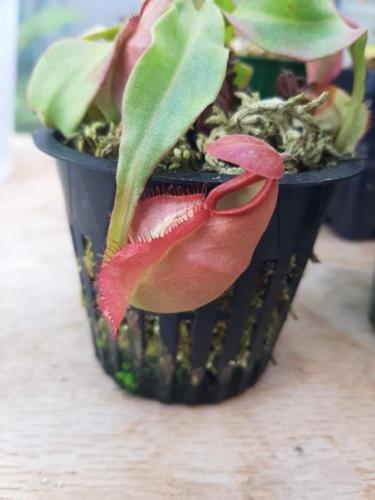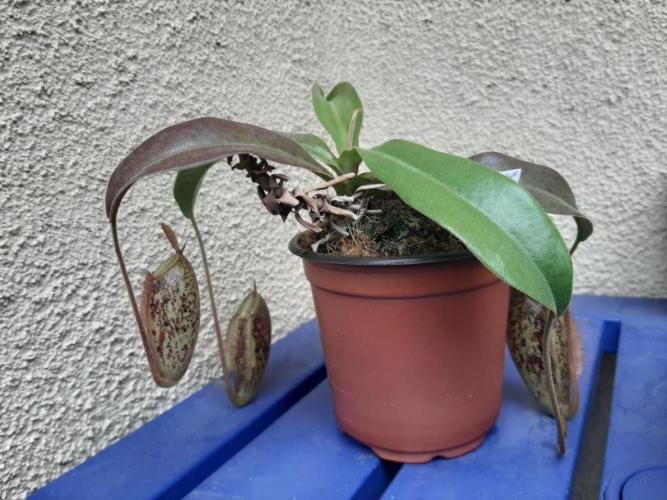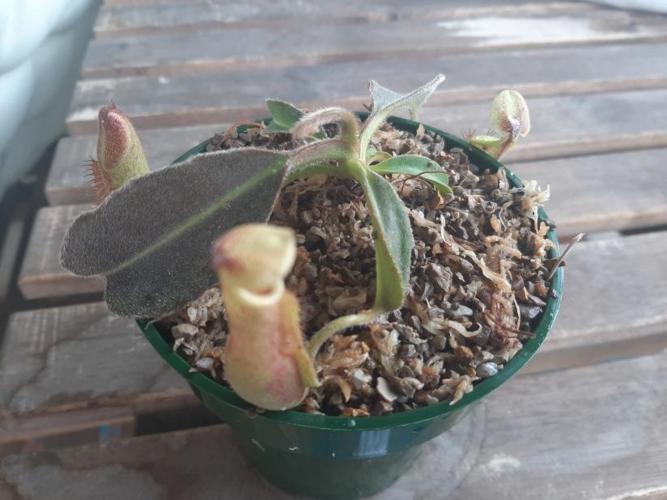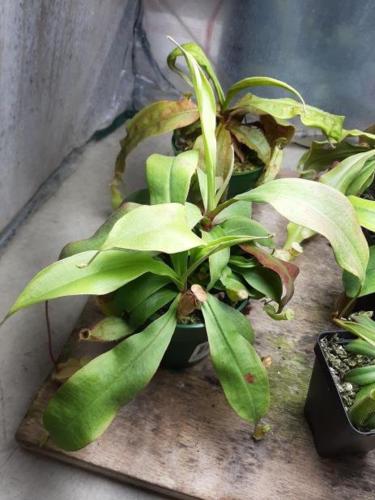January 1, 2021 by Rat Dictator
Nepenthes Primer
A Brief Guide to the Genus
Nepenthes is a genus of mainly carnivorous plants alone in the family Nepenthaceae. The leaves are born from a rosette and possess a tendril at their tips which ends in a pitcher. The pitchers exhibit a variety of shapes and colors depending on their environment and target prey. Most of the species are carnivorous with one detritivorous species and multiple adapted to feed off of the droppings of small mammals including bats and shrews. The genus is highly specialized and occurs only in habitats with low nutrient levels. Many species are epiphytic or lithophytic, while others are terrestrial. The greatest amount of the approximately 175 species occur in southeast Asia with few occurring on islands near Africa or in Australia. It is likely that considering the remoteness of their habitats and the number of species described in the past year alone, this number will soon change.
Acquiring and Establishing a Nepenthes:
The first step to growing one’s own Nepenthes is to get ahold of a plant. In much of the United States, they’re easily found at local garden centers or even hardware stores, although their presence may be patchy. Some lucky growers even have local specialist nurseries or carnivorous plant societies where they can get access to a diverse assortment of Nepenthes grown by experienced collectors. If you do not have such opportunities locally, Nepenthes can be ordered online through Ebay or online nurseries. Plants bought from reputable sources tend to be in good health, while those bought at general nurseries may have a variety of issues. Luckily, it is fairly easy to check plants for issues at the nursery. Unusually pale, brown, or spotted leaves indicate a plant in peril. Do not be bothered by brown pitchers, stems, or pitcher tendrils. Rot in the stem will cause it to be mushy and flimsy. If the plants are in wet peat, there is a chance that the roots are rotting. When buying online, the best thing to do is check the seller reviews, product images, and the title of the listing. Scam listings tend to have incoherent titles that are a conglomerate of key words. Most often they include phrases such as “bonsai,” “rare” and oddly enough, “eats mosquito,” while neglecting to state the species of the plant they claim to be selling. Once you have acquired your Nepenthes, the first step is to acclimate it. This is done by providing it with indirect light and high humidity. Humidity can be raised by putting the plant into a plastic bag and keeping it shut. Over the course of a week, slowly open the bag and the plant will have a much easier time adjusting. During or after acclimation, the plants may lose their pitchers. This is a typical response to the new environment and the plant will grow more pitchers off of new leaves it will create. Growth may stall for a week to a month or more depending on the species of Nepenthes and the way it was purchased. Plants bought bare root will take longer to acclimate and adjust.
Lighting
After acclimation, lighting can be gradually increased. Nepenthes are quite adaptable and can handle anywhere from full sun to indirect light all day long. It should however be noted that many of the lowland species are sensitive to full sun and are vulnerable to sunburn, which appears as either crisp or pale patches on the leaves of the plant. This includes N. bicalcarata and N. northiana especially. Indochinese species tend to be the main exception to this rule, with multiple other outliers also existing. It should also be noted that many highlanders prefer indirect lighting when temperatures are very high. Side effects of insufficient light include lack of pitchers and premature vining. In higher light, the leaves of Nepenthes will shrink and possibly gain reddish or purplish colors while the pitchers of the plant will increase greatly in size and color.
Soil & Potting
As with lighting, Nepenthes are extremely flexible with the variety of soils they will tolerate. Soil ingredients may include sphagnum moss, perlite, peat moss, orchid bark, akadama and other clays, coconut bark, sand, and pumice. Beware that some brands of these ingredients contain fertilizers which will kill Nepenthes. All ingredients within their soil should be low in nutrient content. Sphagnum moss is by far the most common and popular substrate, with many growers using only pure sphagnum and nothing more. Sphagnum moss mixed with about a third perlite or pumice allows for improved drainage and is preferable. Certain Nepenthes such as N. rajah demand mixes including high mineral content and exhibit limited success when grown in a mix of purely organic substrates. Two soil additives that are more controversial are coconut coir and peat moss. Coconut coir has been known to contain dangerous levels of salt for Nepenthes while peat moss has extremely poor drainage and should never be used as the majority in a mixture. When potting Nepenthes, you may choose plastic pots with drainage or net pots. Terracotta has been known to occasionally kill Nepenthes due to the minerals it contains. Pot size is generally better kept small and plants tend to only need repotting well after their leafspans double the width of their pots. You will know repotting is necessary when there are roots visible through the drainage holes of the pot.
Watering and Humidity
Watering is based off of many factors including the soil mix, humidity, and temperature. It is easier to do as needed than it is to do on a schedule. A reliable method of watering is to lift a pot and judge whether it needs watering by its weight. This can take time to get used to so until then it is best to water when the surface of the soil has dried completely. Humidity is ideally kept high at about 70% or more. This is only a general recommendation and can be broken with many species. Some, such as _N. truncata _and N. maxima are able to pitcher with an average humidity well below 50%. However, other species including N. tenuis will never do well with humidity that low. In all species, lower humidity will affect pitcher retention even after appropriate acclimation. Younger plants and cuttings will also be more sensitive to dry air.
Temperature
In terms of temperature, Nepenthes fairly consistently fall into three categories. These are the highlanders, intermediates, and lowlanders. Highlanders and intermediates make up the majority of the genus and grow at higher elevations in situ. This means they also appreciate lower temperatures. Most will prefer days in the mid to high 70s to low 80s with nights in the low 60s. However, they can handle temperatures from about the high 30s to 100 for short periods. Certain highlanders including N. inermis will suffer almost immediately in temperatures above 90. Lowlanders prefer days in the 80s and nights in the 70s. They can tolerate extreme heat for longer than highlanders but as soon as temperatures reach the high 40s, many lowlanders will begin to show cold damage.
Nepenthes in the Long Run:
As a result of the rugged environments that Nepenthes inhabit, they are slow growing plants. Providing ideal acclimation, soil, watering, and temperature can all help to speed up the growth of your plant. Fertilizers can also help to increase vigor in your plants. These come in many forms including pellets, liquids, and invertebrate prey. Pellets can be fed to pitchers or be used in soil. The same applies to liquids which can also be sprayed foliarly. And last but not least, insects are obviously fed to the pitchers. In any case, fertilization is best done in moderation to prevent nutrient burn. Pellets and insects are best given infrequently and in small quantity. Liquids are best diluted to far less than their recommended doses. One should take extra caution when fertilizing the soil. Nepenthes roots are very sensitive to soil nutrients and testing for this type of fertilization is best done on plants not valued too highly. All fertilizing is likely to take some experimentation to get just right. Once most Nepenthes reach a sufficient size, they will begin to vine. Vines range from only a few inches tall to many feet long. Upon the vines, a new type of pitcher will form. These pitchers are called upper pitchers and unlike lower pitchers their tendrils form loops. The loops will wrap around anything they can to hoist the vine up and support its weight. After the vine reaches a certain length, it will form an inflorescence with multiple flowers upon it. The plants are either male or female and form flowers of one sex. If flowering plants of both sexes are present, pollination is possible. The seeds will take a few weeks to ripen and will only last a few weeks afterward. Basal rosettes also form at this stage although they are commonly present on immature specimens as well. These, along with vine segments, can be trimmed to create cuttings. Many growers find that basals will decrease the vigor of the original growth point or kill it entirely. If the main growth point is killed, the basal shoot will quickly replace it and reach full size in a matter of months. Eventually, after many years to decades of proper care, a Nepenthes may become a tangled mass of vines and pitchers.
Have questions for Rat Dictator about carnivorous plants or where to buy tiny hats for them? Chat with him on Garden Revival or take a gander at more of his plants on his Instagram.





